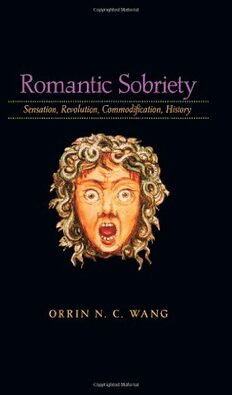
Romantic Sobriety: Sensation, Revolution, Commodification, History PDF
Preview Romantic Sobriety: Sensation, Revolution, Commodification, History
Romantic Sobriety This page intentionally left blank Romantic Sobriety Sensation, Revolution, Commodifi cation, History ORRIN N. C. WANG The Johns Hopkins University Press Baltimore © 2011 The Johns Hopkins University Press All rights reserved. Published 2011 Printed in the United States of America on acid-free paper 2 4 6 8 9 7 5 3 1 The Johns Hopkins University Press 2715 North Charles Street Baltimore, Maryland 21218-4363 www.press.jhu.edu Library of Congress Cataloging-in-Publication Data Wang, Orrin Nan Chung, 1957– Romantic sobriety : sensation, revolution, commodifi cation, history / Orrin N. C. Wang. p. cm. Includes bibliographical references and index. ISBN-13: 978-1-4214-0066-2 (hardcover : alk. paper) ISBN-10: 1-4214-0066-9 (hardcover : alk. paper) 1. Romanticism. 2. Senses and sensation in literature. 3. Marxist criticism. 4. Deconstruction. 5. Literature—History and criticism—Theory, etc. I. Title. PN56.R7W37 2011 809(cid:2).9145—dc22 2010046803 A catalog record for this book is available from the British Library. Special discounts are available for bulk purchases of this book. For more information, please contact Special Sales at 410-516-6936 or [email protected]. The Johns Hopkins University Press uses environmentally friendly book materials, including recycled text paper that is composed of at least 30 percent post- consumer waste, whenever possible. In memory of Betty S. Wang and Richard J. Conroy This page intentionally left blank contents Acknowledgments ix Introduction The Sensation of Romanticism 1 part i periodicity 15 1 Romantic Sobriety 17 2 Kant All Lit Up: Romanticism, Periodicity, and the Catachresis of Genius 36 part ii theory 61 3 De Man, Marx, Rousseau, and the Machine 63 4 Against Theory beside Romanticism: Mute Bodies, Fanatical Seeing 84 5 The Sensation of the Signifi er 111 6 Ghost Theory 138 part iii texts 159 7 Lyric Ritalin: Time and History in “Ode to the West Wind” 163 8 No Satisfaction: High Theory, Cultural Studies, and Don Juan 190 9 Gothic Thought and Surviving Romanticism in Zofl oya and Jane Eyre 218 10 Coming Attractions: Lamia and Cinematic Sensation 250 Coda The Embarrassment of Romanticism 281 Notes 289 Index 357 This page intentionally left blank acknowledgments Unlike the Beatles, I had a lot of help from my friends. A number of individuals read and commented on portions of the book: Jonathan Auerbach, Marshall Brown, James K. Chandler, Jonathan Culler, David L. Clark, William Cohen, Marianne Conroy, Neil Fraistat, Colin Jager, David Kaufmann, Jon Klancher, Marshall Grossman, Brian McGrath, W. J. T. Mitchell, Patrick O’Malley, Daniel O’Quinn, Thomas Pfau, Marc Redfi eld, Hugh Roberts, David Wagenknecht, and Deborah Elise White. I especially want to thank David L. Clark, Jon Klancher, William Galperin, and Peter Manning for their timely interventions and support during diff erent phases of the writing of the manuscript. I’m forever in debt to the smart and perceptive commentary that everyone gave me. All errors and short- comings of the book are my own. I also want to thank Jonathan Auerbach, Mari- anne Conroy, Elizabeth Fay, Neil Fraistat, and Daniel O’Quinn for their advice and encouragement during various moments of the long trek that was this book. Ralph Bauer and Zita Nunes also cheerfully came to my aid in diff erent ways as this project reached its completion. David Rettenmaier and Jeremy Horsefi eld did a splendid job helping me put the manuscript in order; the P. G. Cool Pool and Alex Paraskevas helped with the chakra side of things. Dan S. Wang was a friendly intellectual presence throughout the writing of the book. Marshall Grossman inspired this non-Renaissance project in ways that I’m still discover- ing; I miss him greatly. My thanks to my students, to the Washington Area Romanticists Group, and to the University of Maryland Theory Colloquium for providing me audiences where many of the ideas in the book were fi rst formulated and tested. A Univer- sity of Maryland Graduate Research Board Award gave me the necessary push to fi nish writing and conceiving a large portion of the book. An earlier version of chapter 1 appeared in Modern Language Quarterly 60, no. 4 (December 1999); chapters 2 and 4 in Diacritics 30, no. 4 (Winter 2000) and 35, no. 2 (Summer 2005);
